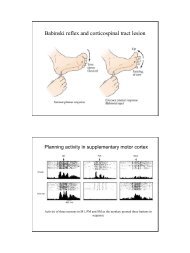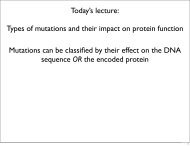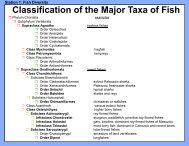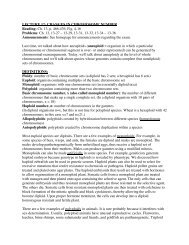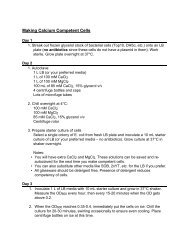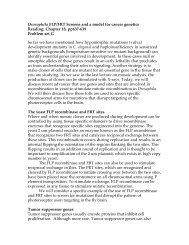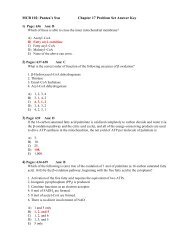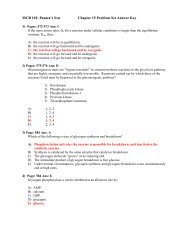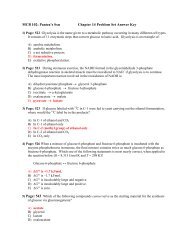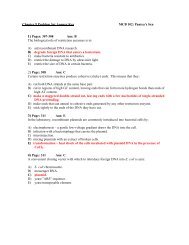alleles
alleles
alleles
Create successful ePaper yourself
Turn your PDF publications into a flip-book with our unique Google optimized e-Paper software.
Mutations (changes in DNA):the lifeblood of genetic analysis(1) What kinds can we make? (categories)(2) How do we make them? (mutagenesis)(3) How do we find them? (mutant screens & selections)(4) Why bother?
Muller categorized mutations with respect tochange in gene function relative to wildtypeLoss-of-(wildtype)function (l-o-f) mutant <strong>alleles</strong>“Gain”-of-(over wildtype)function (g-o-f) mutant <strong>alleles</strong>
to infer the normal function of a gene:LOF <strong>alleles</strong>GOF <strong>alleles</strong>simplest to interpret…to understand what (if anything) they aretelling us about the wildtype gene functionone needs to know the null mutant phenotype.Can use GOF <strong>alleles</strong> to generate LOF <strong>alleles</strong> relatively easily:“revert” (suppress) the dominance of a GOF alleleLOF alleleIllustrated by:ovo D1 antimorphovo e8K hypomorphHow would we know if these female-sterile mutant <strong>alleles</strong>are in the same gene?
Same for Antp 32a5 and Ns 1 , two GOF mutant <strong>alleles</strong>that cause the antenna to develop as a leg instead.revert their dominance(one gets a recessive lethal in each case)and see if the resulting recessive mutant chromosomesfail to complement.
Muller did not just define the five basic ways thefunctioning of a gene can be changed by mutation(without, he noted, changing its ability to faithfully replicate)He gave us operational tests to determineto which class a given mutant allele might belongLoss-of-(wildtype)function (l-o-f) mutant <strong>alleles</strong>complete lof: amorph(ic) (null)partial lof:hypomorph(ic) (leaky)“Gain”-of-(over wildtype)function (g-o-f) mutant <strong>alleles</strong>too much of a good thing:something new & different:hypermorph(ic)neomorph(ic):antagonizes (poisons)wildtype: antimorph(ic)
Muller’s tests: how does the phenotype change when you:(1) hold the number of mutant <strong>alleles</strong> constantand change the number of wildtype <strong>alleles</strong>.(2) hold the number of wildtype <strong>alleles</strong> constantand change the number of mutant <strong>alleles</strong>.increased dose of mutant, phenotype more wildtypethe white gene started it all, and has kept it all going to this dayw + w apricot w -w a /w a (darker, more “wildtype”) > w a /Df(w)2 copies w a allele 1 copy w a allelew a /Y (lighter, less “wildtype”) < w a /Y; Dp(w a )/+1 copy w a allele 2 copies w a allele
See how the phenotype changes when you:(1) hold the number of mutant <strong>alleles</strong> constantand change the number of wildtype <strong>alleles</strong>.increased dose of wildtype, phenotype more wildtype(2) hold the number of wildtype <strong>alleles</strong> constantand change the number of mutant <strong>alleles</strong>.increased dose of mutant, phenotype more wildtypew a /w + (darker, more “wildtype”) > w a /Df(w)1 copy w + allele 0 copies w + allelew a /Y (lighter, less “wildtype”) < w a /Y; Dp(w + )/+0 copies w + allele 1 copy w + allele
Loss-of-(wildtype)function (l-o-f) mutant <strong>alleles</strong>complete lof: amorph(ic) (null)partial lof:hypomorph(ic) (leaky)w apricot“Gain”-of-(over wildtype)function (g-o-f) mutant <strong>alleles</strong>too much of a good thing:something new & different:hypermorph(ic)neomorph(ic):antagonizes (poisons)wildtype: antimorph(ic)
w apricotpartial lof:hypomorph(ic)Increased dose of mutant: phenotype more wildtypeIncreased dose of wildtype: phenotype more wildtypeBut isn’t in RATHER curious then that:w a /w a = (same color as) w a /YO +/vOMuller thought so,and realized that he had discoveredX-chromosome dosage compensation:XX=XY (more about that later)
complete lof: amorph(ic) w -Increased dose of mutant: No change in phenotypeIncreased dose of wildtype: phenotype more wildtypepartial lof: hypomorph(ic)w apricotIncreased dose of mutant: phenotype more wildtypeIncreased dose of wildtype: phenotype more wildtypeTruth be known, geneticists take shortcuts (c.f. cis/trans test)The characterization of a mutant allele asa amorphic (null) vs. hypomorphicis generally made based only on a comparison ofthe homozygous mutant to the hemizygous mutant(and with the knowledge that the mutant is recessive):white X /white X vs. white X /Df(w)…potential pitfalls, but a good place to start
“Gain”-of-(over wildtype)function (g-o-f) mutant <strong>alleles</strong>too much of a good thing: hypermorph(ic)Increased dose of mutant: phenotype more mutantIncreased dose of wildtype: phenotype more mutantsomething new & different: neomorph(ic):Increased dose of mutant: No change or more mutant in phenotypeIncreased dose of wildtype: No change in phenotypeour friend from the X-files, Antpantagonizes (poisons)wildtype: antimorph(ic)Increased dose of mutant: phenotype more mutant (if possible)Increased dose of wildtype: phenotype more wildtypeovo D1
Categorized with respect to:Mutations (changes in DNA):(1) change in gene function relative to wildtype(2) molecular nature (Chp 7 and a bit of Chp 8)A) single base pair (point mutation)kind of transition (Pur>Pur or Pyr>Pyr)base change transversion (Pur>Pyr)effect frameshift (reading frame changed)on missense (amino acid difference)translation nonsense (translation terminates)B) more than a single base pairchromosomal (enough to see cytologically)pseudopoint(cytologically invisible, and small enough to makeit hard to distinguish genetically from a point)e.g. transposon insertions
Categorized with respect to:Mutations (changes in DNA):(1) change in gene function relative to wildtype(2) molecular nature(3) Effect on organisma) Lethal (generally developmental) (most common)b) sterile (sterility is the genetic equivalent of death)c) homeotic (replacement by an inappropriate structure)d) visible (“morphological”)most useful as “genetic markers” if:easily distinguishable (high expressivity)reliably distinguishable (high penetrance)fully viable and fertilein many cases,molecular markers are supplanting (RFLP, PCR,Microarrays)e) conditional [key for microbial (haploid) geneticsbut useful for all genetics]
categories of conditional mutations:1. auxotrophic(new nutritional requirement for growthrelative to wildtype [prototroph])2. host range (infectivity/virulence) parasite “nutrition”Sxl M1dominant3. sex-limited/specific (including dominant lethals & steriles)male lethal4. genetically suppressable:dominant vs.recessive suppression…varient allele at a different gene counteractsa mut /a mut ; sup + /sup + = mutant phenotypea mut /a mut ; sup Mut /sup += wildtype phenotypea mut /a mut ; sup mut /sup mut = wildtype phenotype(in haploids: a mut ; sup mut = wildtype phenotype)A mutation that makes a bad situation better is more likely tobe informative than one that makes a bad situation worse(…and of course is likely to occur less frequently!)
categories of conditional mutations:1. auxotrophic(new nutritional requirement for growthrelative to wildtype [prototroph] )2. host range (infectivity/virulence) parasite “nutrition”3. sex-limited/specific (including dominant lethals & steriles)4. genetically suppressable5. temperature-sensitive (ts)



